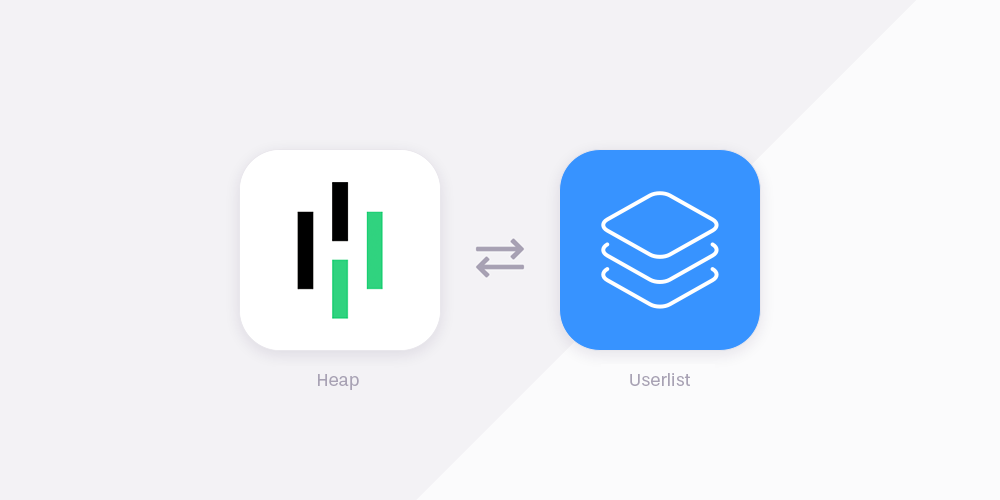User onboarding is one of the most fundamentally important steps in the SaaS user journey. It won’t matter if you get your users to sign up or pay for your product if they don’t know how to use it. Or if they haven’t added it to their daily workflows — they’ll churn.
User onboarding is much more than just letting your users know how your product works. It’s about letting them know the value of it, as well as helping them add it to their already existing procedures and ways of working.
Having a poor user onboarding experience can harm your SaaS because you’re losing customers you’ve already put the work in for. Meaning, all of those resources have contributed to nothing more than a negative review on G2.
In this guide, we’ll help you create an onboarding experience that has your customers see your product value, achieve their job to be done, and remain a long-term, active user. Come and fight churn with us.
Don’t wait for the muse. Apply this step-by-step method to write high-performing email campaigns in hours, not weeks.
What is SaaS user onboarding?
User onboarding is the experience that a SaaS company designs for first-time product users so that they can get product value as quickly as possible.
Gauri Manglik, CEO & Co-founder of Instrumentl, shares what onboarding is for him:
“Onboarding is one of the most important components of a successful SaaS company. It’s what sets you apart from competitors and demonstrates your commitment to customer success.
Any successful SaaS company needs an onboarding strategy that helps new customers get up to speed as quickly as possible.”
User onboarding is as crucial to your business as it is having a product, and it brings more than just one benefit.
Padmaja Santhanam, Partner & Growth Manager at FirstPrinciples, affirms this:
“From my anecdotal experience with user onboarding, I’ve learned that it has myriad benefits, including increased user adoption and engagement, improved conversion rates, and decreased user abandonment.
User onboarding can also help reduce support calls and account teams by providing support documentation and instructions online or in-app. It frees up resources that can be used to provide better service to other users.”
However, many believe that onboarding is just showing the user how to use the product, when in reality that’s a misconception.
Like Florent Merian, growth marketing manager at Specify, very eloquently puts it:
“The objective of onboarding is to make users fall in love with your product — enticing and converting them into lifelong customers. You must help them get their job done and reach the Aha! moment — when new users first realize the value of your product — as soon as possible. To do this, your onboarding flow needs to answer: What should I know about your product? Is there anything I shouldn’t miss?”
Lorena Martinez, product and lifecycle marketer at Parabol, dives deeper into the Aha Moment:
“There are different Aha moments during an onboarding process. These occur when users are able to answer these questions: how can this product help me? (Value perception); When I use this product for the first time, is it actually helping me solve a problem? (Value Realization); and how do I integrate this in my workflow? (Value adoption).
It’s helpful to view onboarding as supporting users to form a new habit to improve something in their lives, rather than as an exercise in teaching users about our product. When you see it this way, your onboarding journey never ends.”
In SaaS, a typical onboarding process would include:
- A signup flow
- A welcome screen
- Checklists
- Tooltips
- In-app guidance
- Emails
- Calls
- Webinars
Now that we understand SaaS onboarding is, what it really is, and the types that exist, let’s have a look at why you need one:
Why do you need SaaS customer onboarding?
Customer onboarding is quintessential for all SaaS companies, but don’t just take our word for it, look at the numbers:
- 97% of companies say that to achieve product growth a good user onboarding is necessary (UserGuiding)
- 82% of enterprise organizations say their onboarding is a key driver of value (Precursive)
- 74% of companies acknowledge the importance of onboarding and have a dedicated customer onboarding team (Precursive)
- More than 50% of companies across all segments have VP representation now for customer onboarding – or one that reports to a VP directly (Precursive)
- 8 out of 10 users admit to having deleted an app because they didn’t know how to use it (Wyzowl)
- 86% of people say they’d be more likely to stay loyal to a business that invests in onboarding content that welcomes and educates them after they’ve bought (Wyzowl)
- 74% of potential customers will switch to other solutions if the onboarding process is complicated (Userpilot)
However, not everything is good news, and there is definitely room – and a need – for improvement:
- Almost 60% of companies say they’re not satisfied with their current user onboarding experience for their product (UserGuiding)
- Over 90% of customers feel that the companies they buy from ‘could do better’ when it comes to onboarding new users/customers (Wyzowl)
The numbers definitely don’t lie: user onboarding is the most important part of the SaaS customer journey because it’s the one that makes or breaks your business.
Despite what you might think, user onboarding is just as important for free users as it is for paying customers. Especially because only by properly onboarding can you eventually turn free users into paying customers.
Now we know what it is and how important it is, but how do we actually do it?
How do we create a SaaS onboarding experience that has just the right amount of friction? One that takes users to their Aha! Moment fast enough? One that shows users everything that you have to offer without overwhelming them or confusing them?
Keep reading to find out or have a listen to our conversation with Kim Gjerstad on user onboarding and freemium challenges.
How to create a great SaaS onboarding experience in three steps
There are a few things you’ll definitely need to consider to create a SaaS onboarding that leaves first-time users turning into lifelong customers. Let’s have a look at what they are and how to implement them into your strategy:
Step 1. Find the right amount of friction
The next thing you should consider is reducing friction during your process. Although, Ramli John points out, not all friction is bad:
“For example, a welcome video, although it makes them take longer to reach the product, it builds an emotional connection to the product, the brand, the founders, and that can be valuable. So that’s a friction that’s worth having.”
Although you want your users to reach their aha! moment as soon as possible, you might benefit from some friction. Be mindful that during the initial stages of onboarding, your users are motivated and have more energy so it’s a good moment to consider friction. If it’s serving a purpose and educating or helping a user connect more deeply with the brand or product.
According to Vitally:
“When [frictionless onboarding is] taken to the extreme, you risk cutting valuable context and guideposts, ultimately detracting from the experience. The goal of user onboarding is not to get the user to experience your product as quickly as possible. It’s to help them adopt new product habits, understand the full value of your product, and keep coming back for more. Habit-formation requires some friction.”
Step 2. Create quality onboarding materials
Another important aspect to watch out for is the onboarding materials that you’ll be creating for your experience.
Examples of onboarding materials are:
- Surveys for segmentation and personalization
- Explanatory and welcome videos
- Webinars
- Worksheets
- Blog posts and guides
- Walk-through modals
- In-app messages
- Emails
- and plenty more
Onboarding is not just about sending emails, or the in-app tips and messages to guide users through what’s happening. No, it’s a complex process that involves a lot of content in order to educate your users properly and it needs to be delivered wherever your users are most likely to engage with it.
There are different types of content that might suit your industry, your business, or your users better – but variety is always a good friend of yours. This way, you’re not just targeting one user persona, but a whole variety of them.
Step 3. Set up your onboarding calls
Onboarding calls (and other custom scheduling links) are a great way to personally connect with your users and walk them through your software.
When deciding whether or not you want to include calls in your onboarding, you need to think if it’s worth the extra human resource and time spent in order to give that human touch and thorough explanation. It might be best to use webinars, videos, and other interactive onboarding methods to have your users get to grips with your product quickly.
For example, we offer different types of onboarding calls during user onboarding at Userlist: a general onboarding call, a technical setup call, and a campaign strategy call. Scheduling tools like SavvyCal make it easy to open up your schedule with dedicated links.
Luke Genoyer, Marketing Director at United World Telecom, shares with us his onboarding call preparation and process:
Pre-call
- Research the company and connect with the decision-makers on LinkedIn
- Check to see what services the customer ordered and whether they’ve already started testing the service
During the call
- Ask the customer if they’re satisfied with how the service works
- Ask if they’ve used or are currently using this type of service already
- Ask if they need help with further testing or configuration of advanced features
- Log in to the customer’s control panel together with the customer. Go over our main features
- Ask if there are other people involved in setting up the service
- Explain how to reach our 24/7 tech support team
- Ask them how they’re using the service to understand the scope of the project
- Ask about their business and use cases to gauge up-selling and cross-selling opportunities
Here’s a SaaS onboarding email we send at Userlist when we check if new users have started tracking data yet. If not, we invite them to book a technical call:
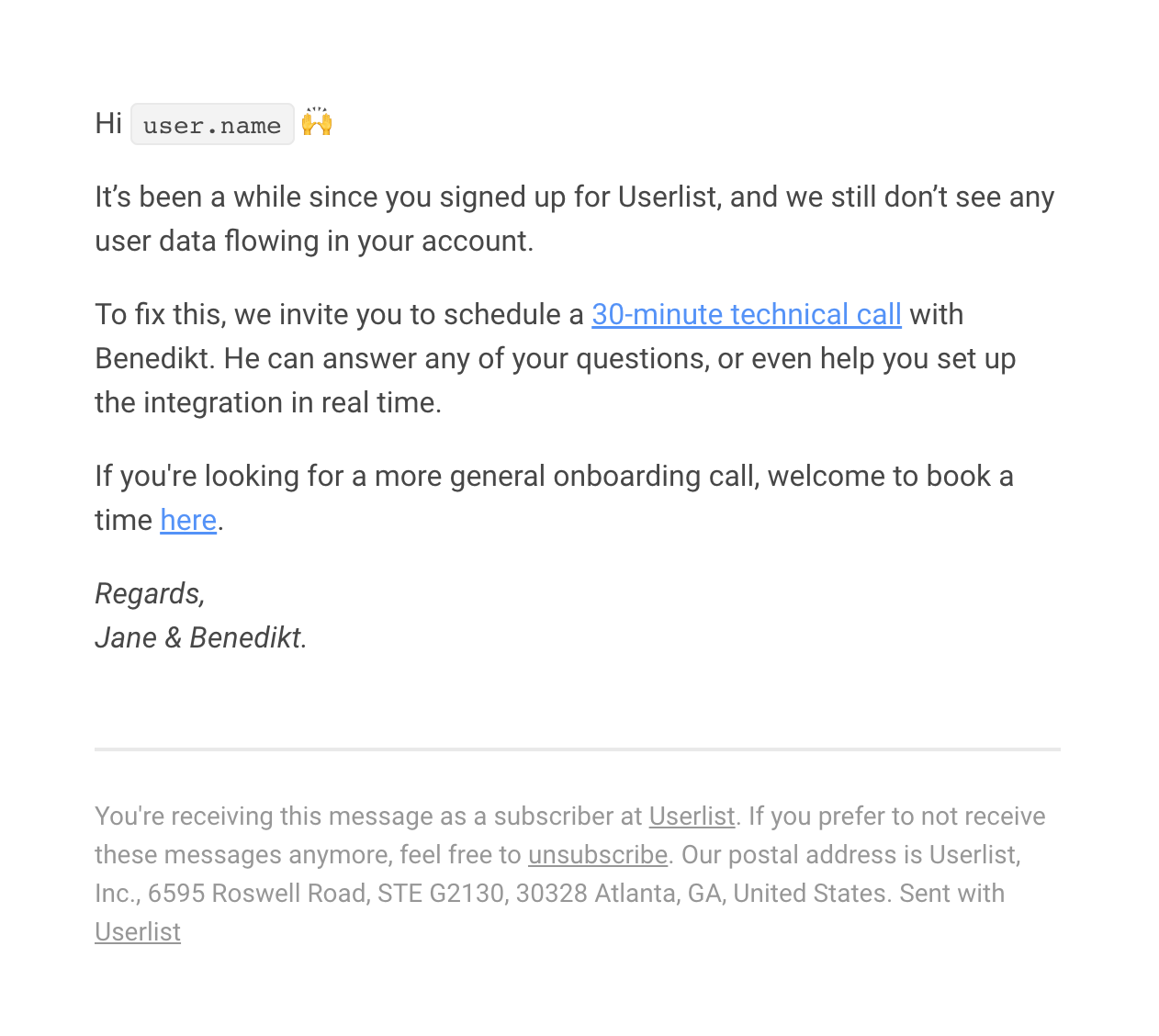
Step 4. Automating your processes
Automation is not a new word in this space. In fact, thanks to the internet and technology, automation is not only a good thing to have, but necessary.
There are tools that help you automate email sequences and segmentation — hello, Userlist is here for you! — or help you automate your step-by-step tutorials, or micro surveys to garner in-app onboarding feedback. Finding the tools that will help you reduce your customer onboarding experience design and time frame is no easy task, but stay tuned for the rundown of the top tools we think you’ll love to use.
Let’s take a look at the checklist that you’ll need to run through in order to create the ultimate SaaS user onboarding campaign and experience:
The ultimate SaaS onboarding checklist (with examples)
Use this checklist as a final runthrough before launching your onboarding experience. There’s no particular order to it, but answering each of these questions will give you a churn-proof onboarding experience.
#1. Primary job-to-be-done
Are you clearly explaining how your user can accomplish their primary job-to-be-done?
The famous ‘aha! moment’– and we say famous because there is no marketer, product designer, or sales person that wont say those words when referring to the onboarding experience. The aha! moment is the moment a user realizes the value of the product for them — they should exclaim: “Aha!.”
For example, the user sends an automated and segmented email campaign on Userlist without spending hours, and “Aha! I couldn’t do this with my normal email app!”
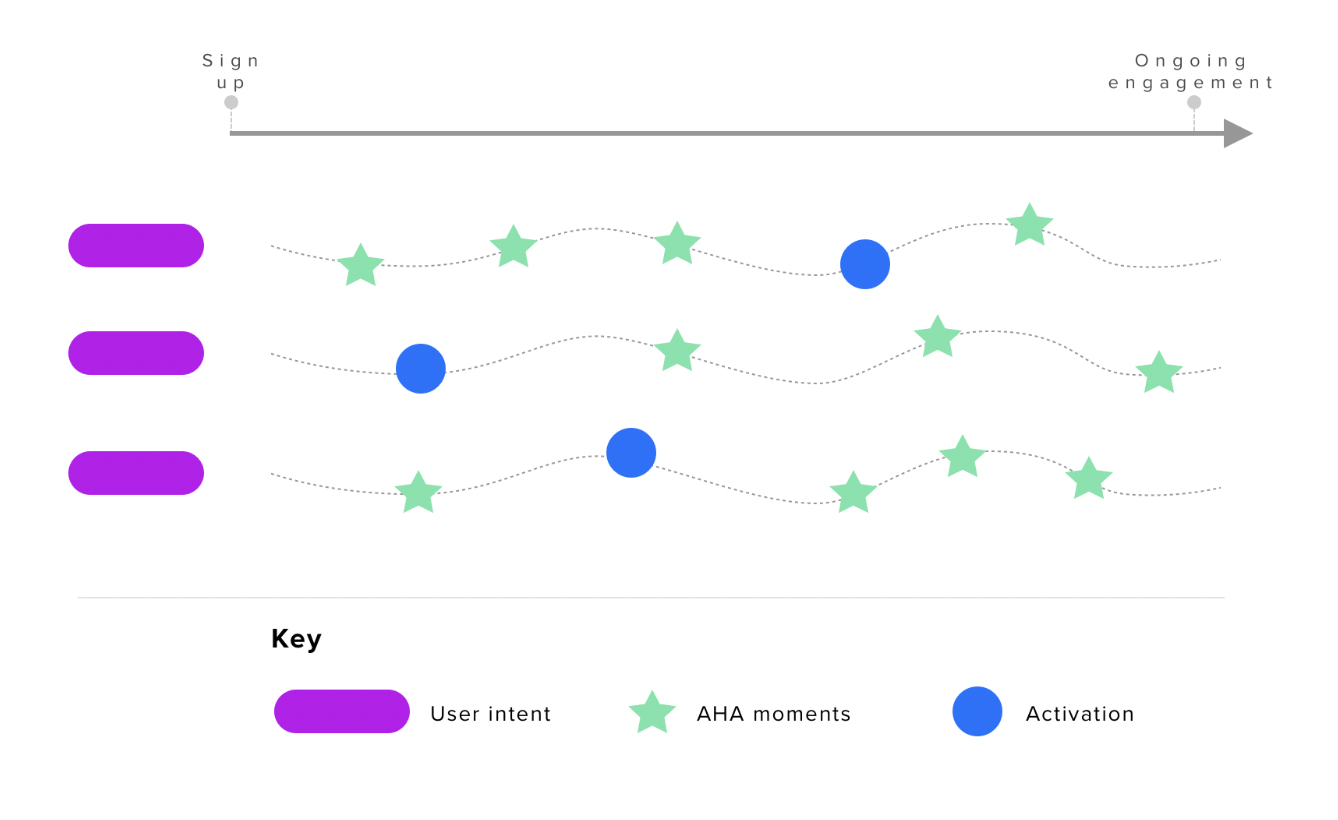
However, this value will only be realized, if you’ve established the user’s job-to-be-done correctly.
Jobs-to-be-done, or JTBD, are the primary reasons that triggered someone to buy or subscribe to your product, like what Ramli John said in an episode of Better Done than Perfect:
“Jobs-to-be-done are the emotional, social, or functional reasons that somebody had for signing up to your product. Once you figure that out you can really personalize your onboarding experience. […] you won’t be very successful at onboarding a user if there is a disconnect between what they perceived you were going to solve for them, and what they actually experienced from your onboarding.”
Without really understanding what your customer is looking for – and what your product can solve for them – everything from your onboarding experience, to your product marketing and sales will be lacking.
Lorena Martinez shares her thoughts about how you can manage your users expectations from the beginning in order to better achieve aha moments:
“In my opinion, the most important element in onboarding is the first touchpoint users have with the product/brand: your website, your social media profile, ads, etc.
For example, we are an agile meeting tool to help remote teams make meetings run on-time, on-point and with everyone’s input. If our website visitors thought we were a video conferencing service when they signed up, we wouldn’t have any users. It doesn’t matter how good our onboarding strategy is.”
Focus on finding your users’ JTBD, and pave a pathway of Aha! moments to get there.
One of the best ways to get to understand your user’s job to be done is simple: ask them.
Perform customer interviews, questionnaires, surveys, and any method that allows you to get that information out of the user:
- What are their pain points?
- What are they trying to accomplish with your product?
- How would the desirable outcome look for them?
Remember: customers are loyal to the job-to-be-done, not to the solutions – products or services – they use. The closer you get to uncovering their jobs to be done, the more chances you have to create a positive onboarding experience that will help you improve your customer retention and turn new clients into loyal customers.
#2. Ideal customer profile (ICP)
Who is your ICP? Are you catering to them well?
Knowing who your ideal customer is, or your ideal buyer, helps you understand what you’ll need to better cater to them. This in turn will help you improve your customer relationship through more effective customer engagement efforts.
The best way to understand your ICP is by creating buyer personas. Buyer personas are fictional representations of your ideal customers done based on quantitative and qualitative research.
Based on our own experience, what you need to create useful buyer personas – which will help you better target and understand your customers – are four simple steps:
- Define your ideal customer
- Conduct interviews and surveys to identify their existing struggles
- Organize all the qualitative raw data into meaningful and actionable data
- Build, test, and learn
If you want to dive deeper, check how we conducted our own effective customer research.
Once you understand your ICP through your buyer personas, you’ll have better chances at designing a SaaS onboarding experience that’s customer-focused.
#3. Interactivity
Does your onboarding experience and tools allow for interactivity and user choice?
Depending on the complexity of your product and who you’re onboarding you might decide on a low-touch or a high-touch onboarding method.
What is low-touch onboarding?
Low-touch onboarding, or self-serve, is a method that relies on little-to-no human interaction with users. This means that the customer will be guided by in-app guided, comprehensive onboarding materials, user guides, FAQs and all sorts of other documents and tools.
Quick fact, 40% of users say they prefer self-service over human contact.
What is high-touch onboarding?
High-touch onboarding experiences will rely much more on step-by-step tutorials from your dedicated onboarding team. These methods are done via calls, chatbox, help centers, and other contact points before the user can fully benefit from your product.
Larry Barker, Senior Manager, Customer Support Operations at Articulate Global, says:
“For a more technical or complex product, you might opt for a high touch human approach. For other products, tools like Chameleon or Stonly can make for a great digital onboarding experience.”
When should you decide for a more low-touch – interactive – onboarding, instead of a high-touch onboarding?
- If you’re a medium or big size business that is looking to grow faster – interactive and automated experiences are more affordable for company sizes
- If you’re a big enterprise that has too many new users to handle with a customer support team – makes onboarding in scale more effective
- If you want to provide the same performance and quality for all users, non-dependant on human factors
- If you have an updates platform, or website – in outdated ones it will be harder to implement
- If your product needs a short or medium length onboarding process – if it’s too complicated you might prefer high-touch onboarding
Ready to make your SaaS onboarding move on autopilot? Read how to switch to self-service onboarding.
#4. User autonomy
Can the user explore the product at their own pace?
It’s important to let the user know they can pause and even decide if they want to take a product tour at all or just continue exploring on their own with tooltips popping up along their journey.
In the Twitter example below, you can see how they give the option to skip or fill the description box.
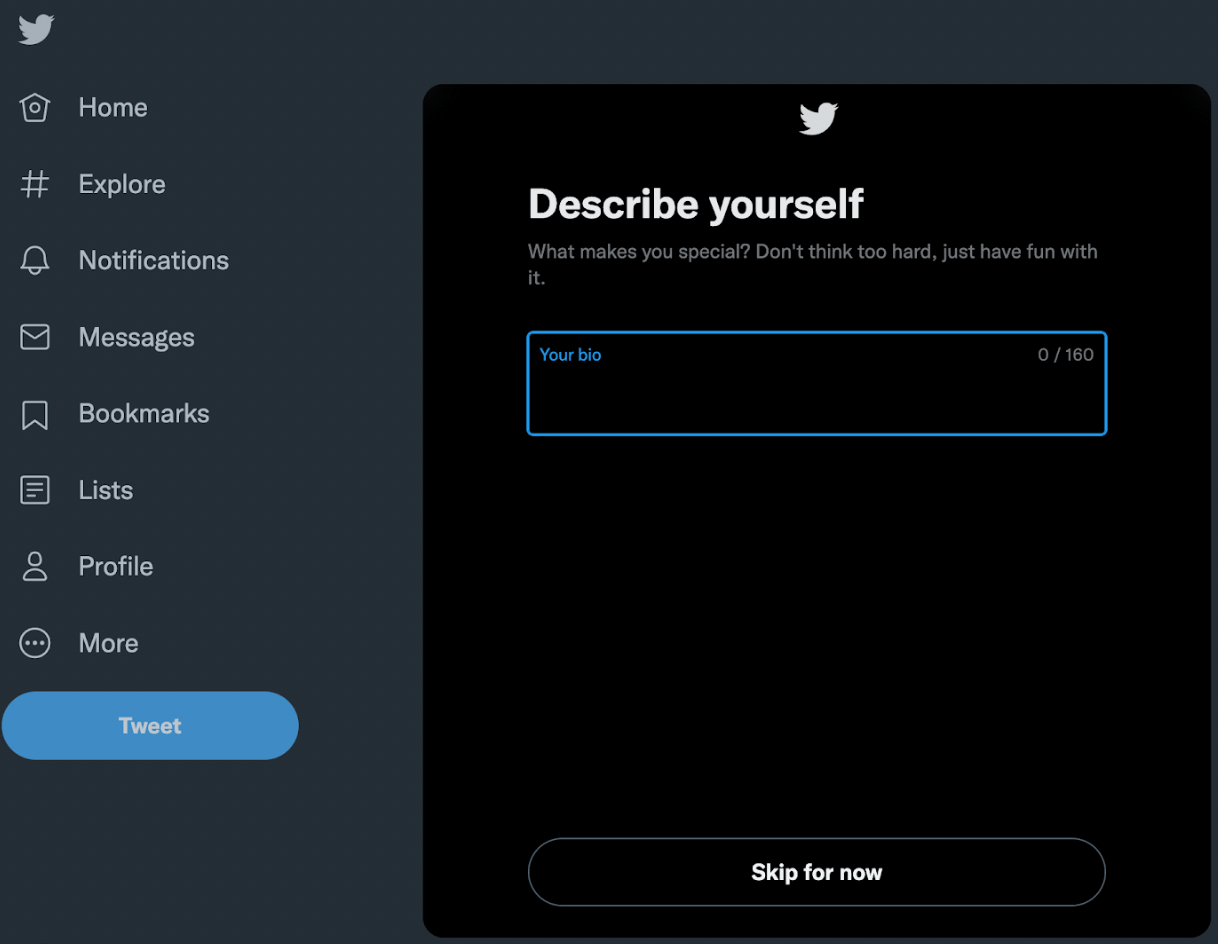
Oftentimes, product tours are not effective — it’s exactly because they interrupt the autonomous user journey. Disclaimer: it’s not all black and white, and they can still be useful. But it’s an important factor to consider.
#5. Documentation
Is there a way to quickly access your help docs?
You need to create helpful resources so your users can better understand your product, get their JTBD, and really solve their pain points.
Sharing resources on your welcome and onboarding emails is a great way to have users know where self-serve documentation is at.
In the example below, you can see how we share useful resources so a new user can solve their struggles faster.
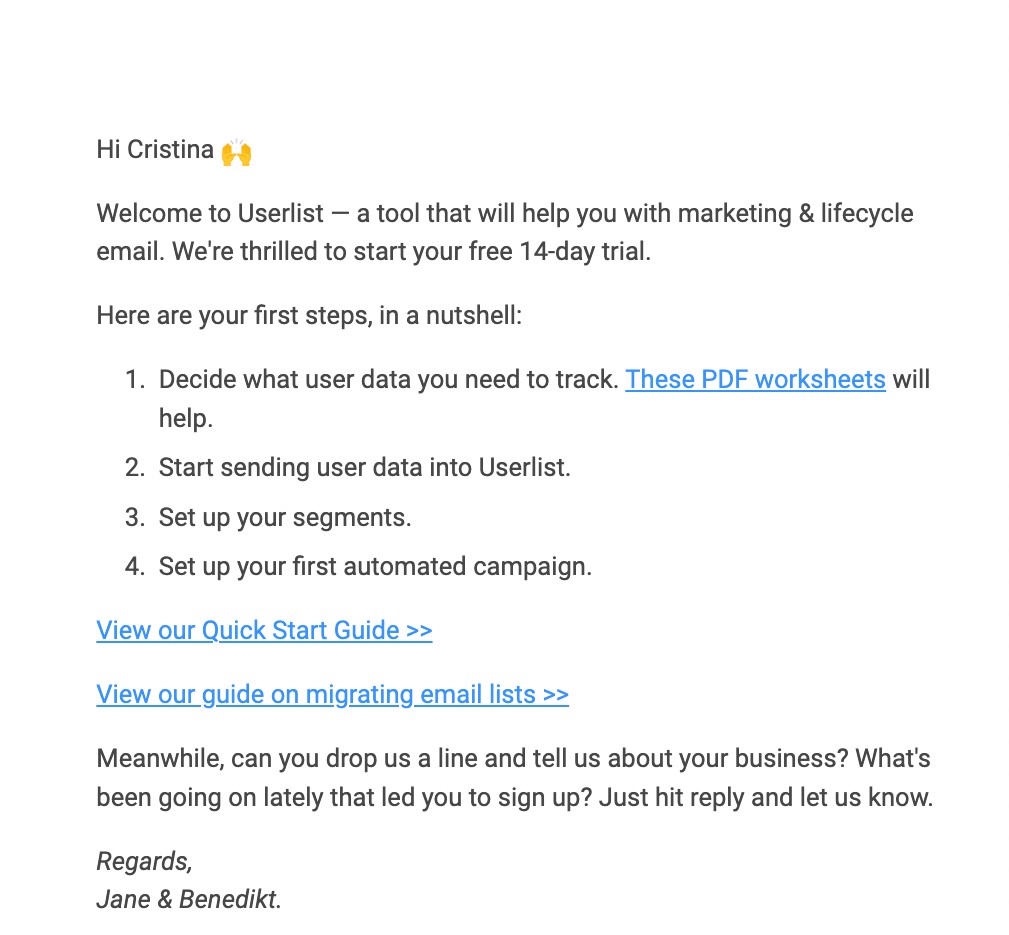
#6. Empty states
When data is missing, is there an attractive & informative blank state?
Empty states are those blank screens when the app has no information yet and can’t show anything meaningful. For example, when you haven’t added any friends or interests on Facebook, you’ll be shown an empty state when you try to see your home page.
Empty states help the user remain autonomous by letting them explore and navigate around your product with the possibility of being able to come back to that empty state.
Below are some example of empty states that include the three most important aspects they should include:
- Copy that lets the user know what’s happening
- An eye-catching image so the blank state doesn’t look too blank – this can cause some anxiety to the user
- A great call-to-action (CTA) that lets the user know exactly what they are expected to do
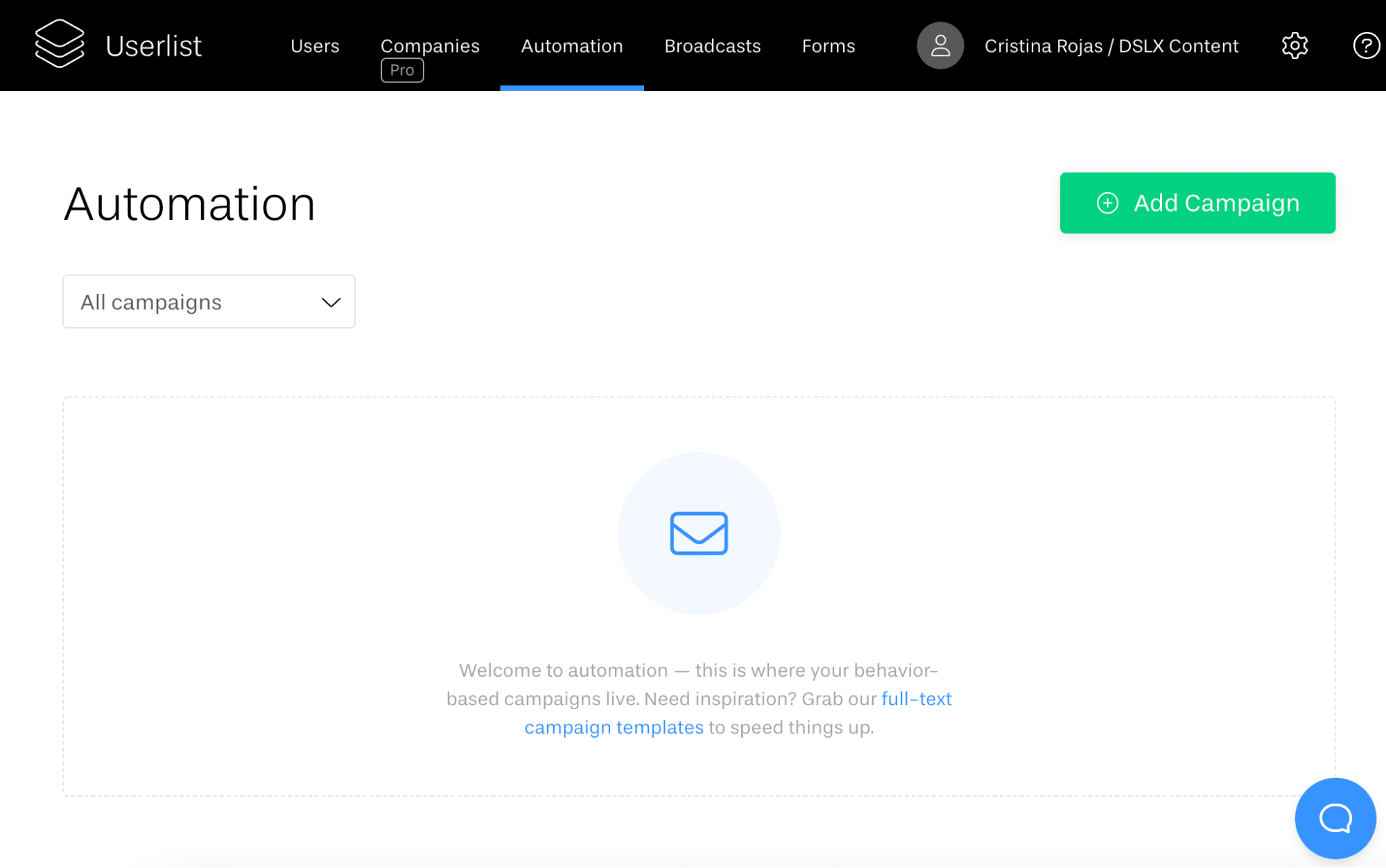
#7. Progress tracking
Do users know where they are in their onboarding process?
Providing the user with a progress tracking bar, like the example below, improves onboarding completion rate by 12% and reduces premature-exiting of the onboarding experience by 20%.
The same research highlights that showing an onboarding checklist to your user increases tour completion by 21%!
Take a look at Bungalow’s progress bar and Linktree’s progress bar and onboarding checklist.
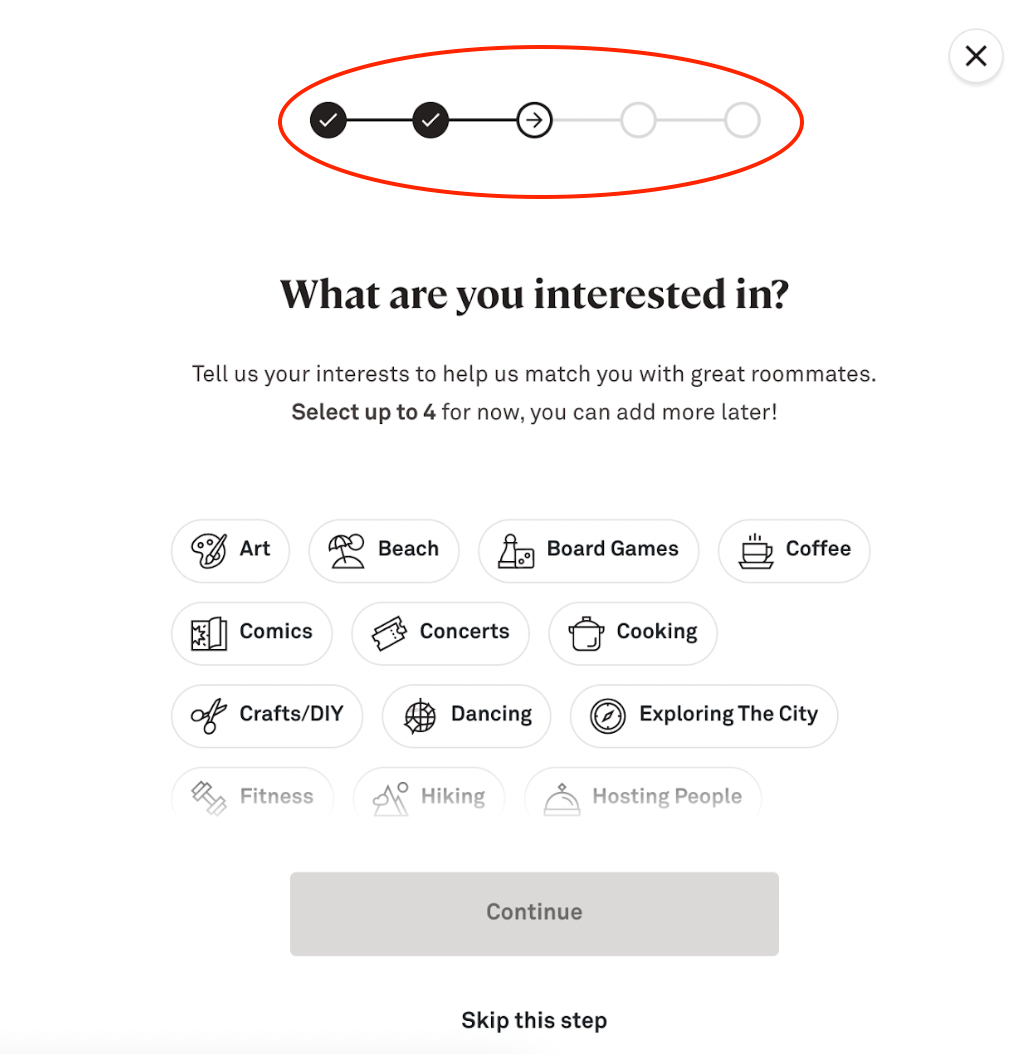
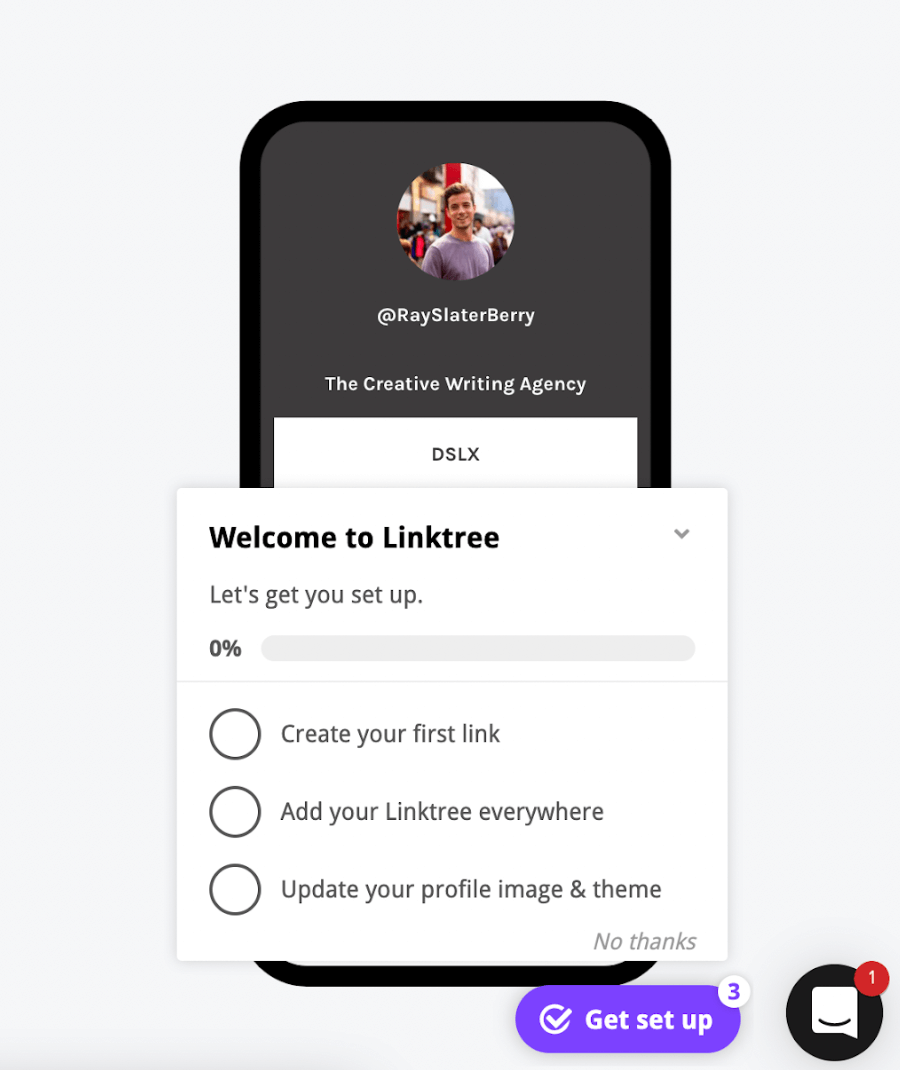
Don’t wait for the muse. Apply this step-by-step method to write high-performing email campaigns in hours, not weeks.
#8. Gamification and rewards
Are you rewarding new users for completing onboarding tasks? How?
This could be as subtle as product animations that celebrate user achievements.
Anything that helps your user move more smoothly through the onboarding process will help you get them to where you want them to be. Using gamification and rewards is a great way to encourage users to move through the process more engaged and even quicker.
Using things like badges, rewards, level completion, and other game-based methods are part of gamifying your onboarding.
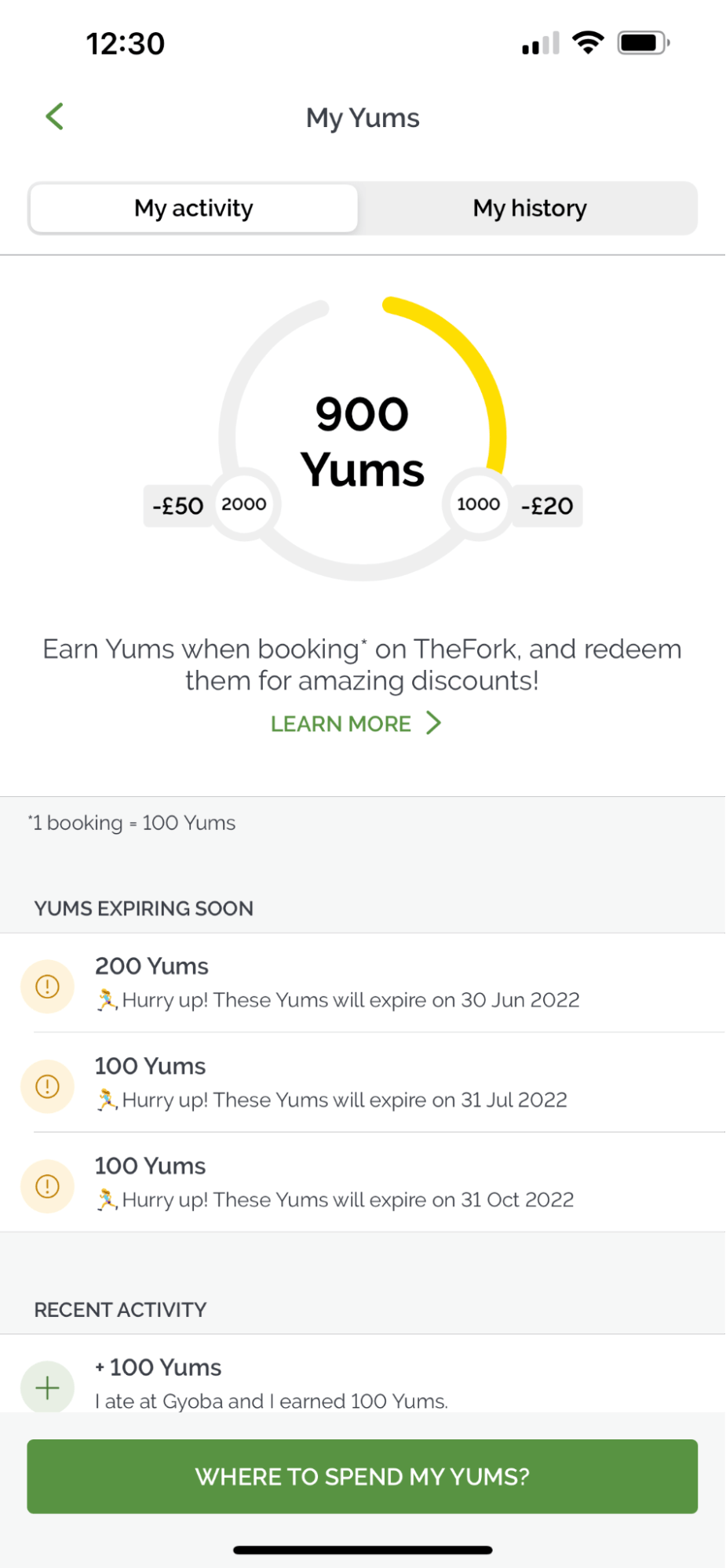
The example above shows how you can gamify your user onboarding to engage your users through rewards and milestones so they are better motivated to add the app to their daily lives.
#9. Exit and re-enter
Is how to exit and re-enter the onboarding experience clear and easy to do?
Think how in today’s world people are constantly busy and being distracted by their job, their phone, or simply by their different commitments in life. When you let your users know that they can safely exit and re-enter their onboarding experience without losing any progress, you’re increasing your chances to see them go through the whole process.
#10. Relevance
Are your onboarding experience tasks relevant to the actual product experience you’re offering?
If you’re onboarding explains how to use only one feature, and it’s not the feature users are interested in – once they get to the product they might be just as confused as if there was no onboarding at all.
Focus your onboarding experience, and if your product has multiple features but you don’t want to overwhelm your customers use onboarding surveys to target the onboarding to their needs.
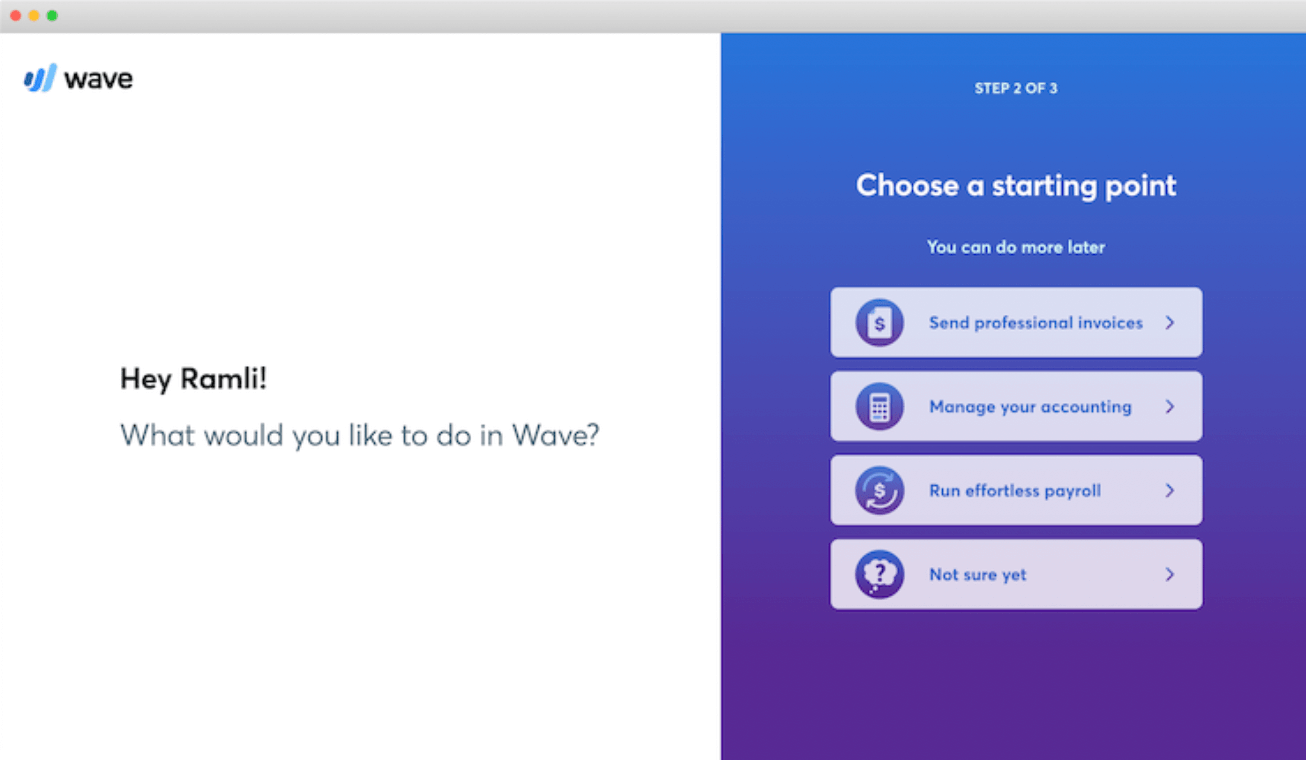
Ramli John mentioned his experiment of clicking all four of the different options that Wave offers in the first step of onboarding and he had completely different experiences. He received different email flows for each that were targeted for the specific purpose he had mentioned as important to him.
This is a great example of relevance and personalized recommendations without having to make their product simple, or onboarding super complicated.
#11. Clarity
Does each onboarding step have a single goal? Are your onboarding outcomes clear and measurable?
Thinking about how to make your users’ life better, the simpler and straightforward that each step of onboarding is, the more they will follow through.
You don’t want your user to be testing multiple features in each step, or have one step that’s so long that your user might get frustrated and leave. Make your user feel as comfortable as possible.
#12. Measurability and improvement
Is someone responsible for monitoring onboarding success? Are you iterating and improving your onboarding experience frequently? Have you refined which metrics you need to measure to find out the user ‘tipping point’?
User activation metrics go beyond the sign up or free trial or even first payment. To truly understand the success of your user onboarding you need to know when the user has reached a ‘tipping point.’ To better understand what this point is let’s look at Slack’s example by Ramli John:
“For Slack, the aha! moment is sending a message. Super simple. But for them, and their onboarding team, their goal is to get teams to send 2K messages. This is because they found that 93% of teams that did that are still with Slack today. That’s the metric that really tells them if they have successfully onboarded a user.”
Additionally, for SaaS companies that are subscription based, you want to have a customer success team that really focuses on onboarding and is constantly monitoring and measuring your users’ success. If you want to learn more about customer success and important metrics in terms of jobs to be done you can check this UI Breakfast episode with Jim Kalbach.
#13. Contact information
Is there an obvious way to speak with a human? A scheduling link? A contact form?
No matter how interactive your user onboarding is, if your users have any questions or comments you want to be available for them. Make it clear where and how they can contact you.
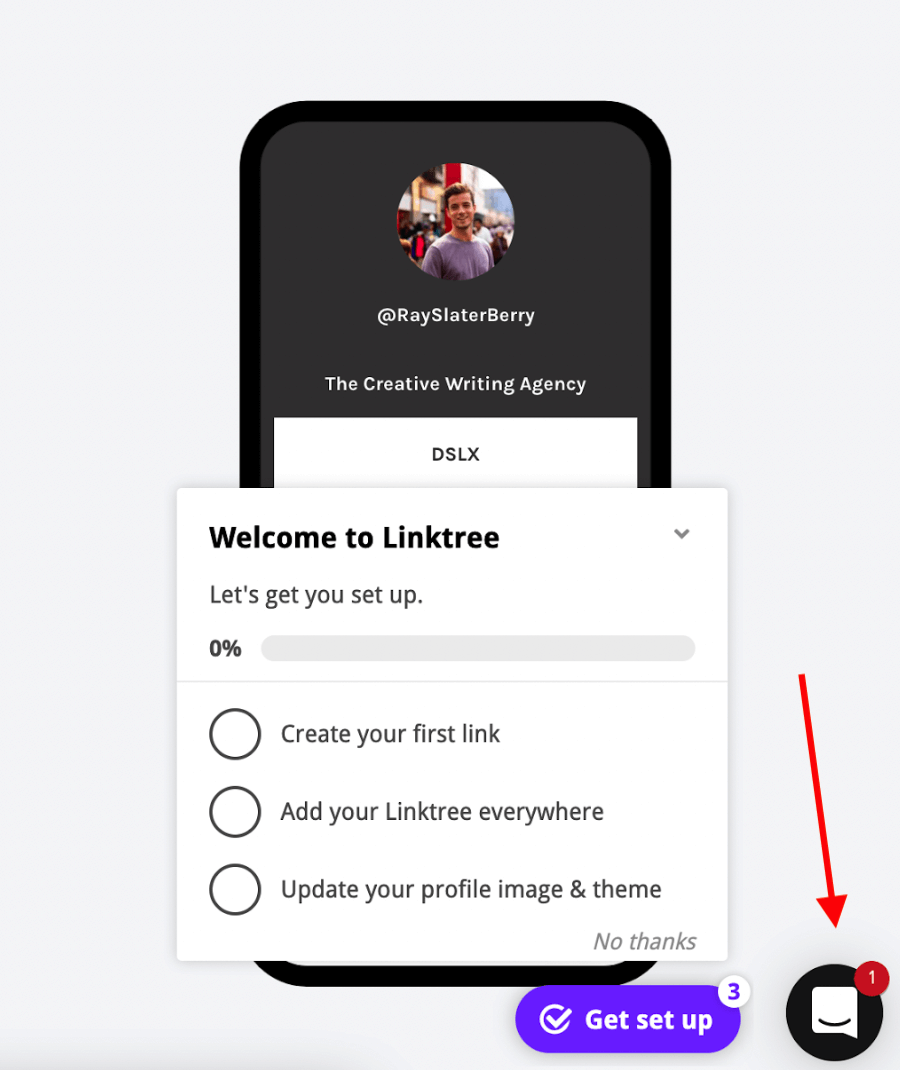
#14. Feedback
Is there a way for users to submit feedback about the experience?
The more feedback you get, the better you can make onboarding for your users. Get surveys in place, or feedback emails to know what your clients are thinking about your product and the overall onboarding experience.
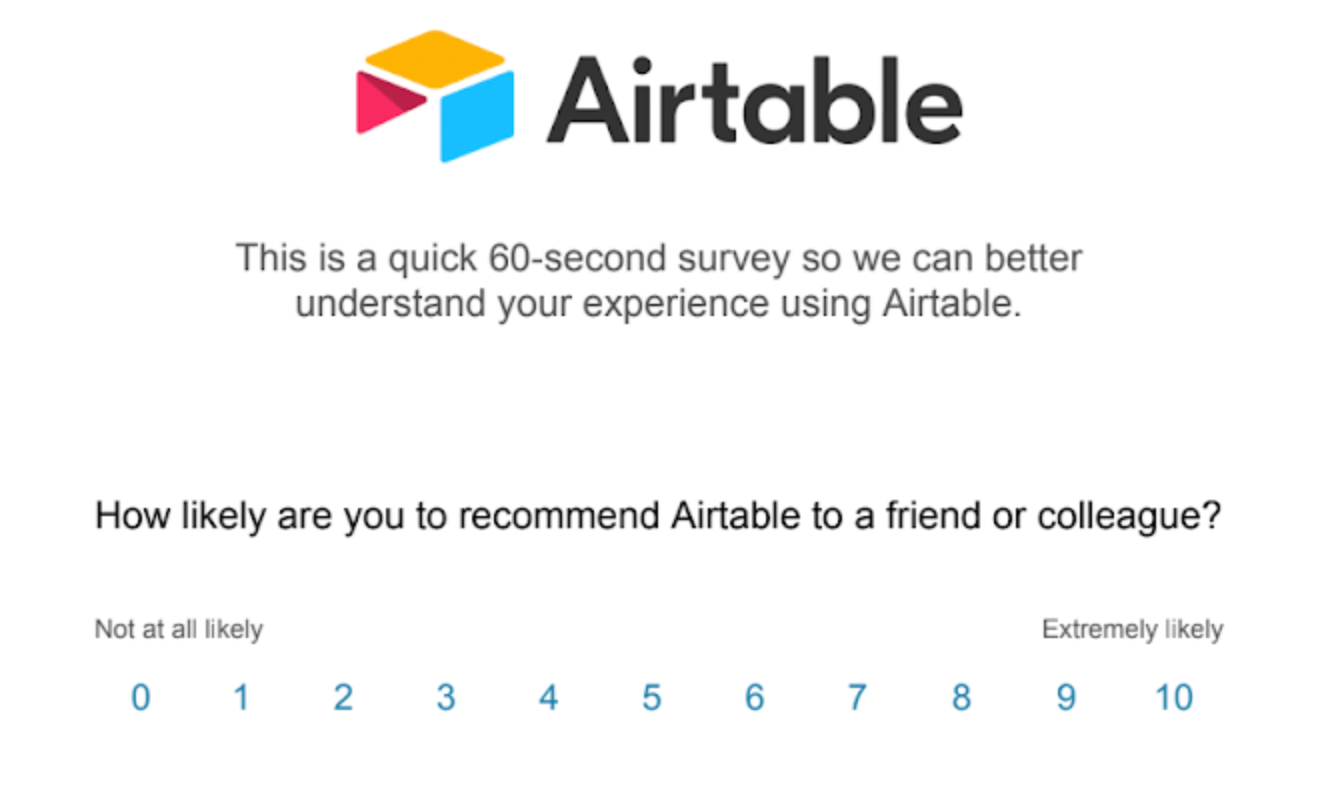
This NPS survey example with Airtable is just one way to get feedback, and whether they answer positively or negatively you can send follow through emails to really know what they like or disliked.
Tools to make your SaaS onboarding process easier
- Userlist focuses specifically on the needs of SaaS companies and helps you achieve automated behavior-based customer messaging through email campaigns and in-app messages designed to onboard, engage, and nurture customers and marketing leads.
- Hotjar offers analysis and feedback tools to know what your users are thinking
- InnerTrends has pre-built product analytics reports so you can get faster insights
- Amplitude helps businesses track visitors and users’ behaviors with the use of their collaborative analytics.
- Qualtrics allows users to create surveys, feedback forms and polls, as well as generate reports without programming knowledge
- Help Scout offers shared inbox, help center, and live chat software to better manage customer communications
- Intercom provides scalable business two-way messaging to improve customer relationships
- Userflow lets whole teams build customizable in-app tours, checklists, and surveys without needing to code a single line
- Chameleon empowers SaaS teams to build self-service and interactive user onboarding, feature adoption, and feedback collection.
- Refiner is a user feedback and customer survey solution that helps SaaS teams be data-driven
- Rocketlane is a customer project management platform to help improve onboarding customer experience
The best examples of SaaS onboarding to learn from
Todoist: seize the elements of your product to show your product
Todoist is a task management tool. It helps you organize your tasks, projects, comments, attachments, notifications, and anything else you need to get organized and ticking your to-do list.
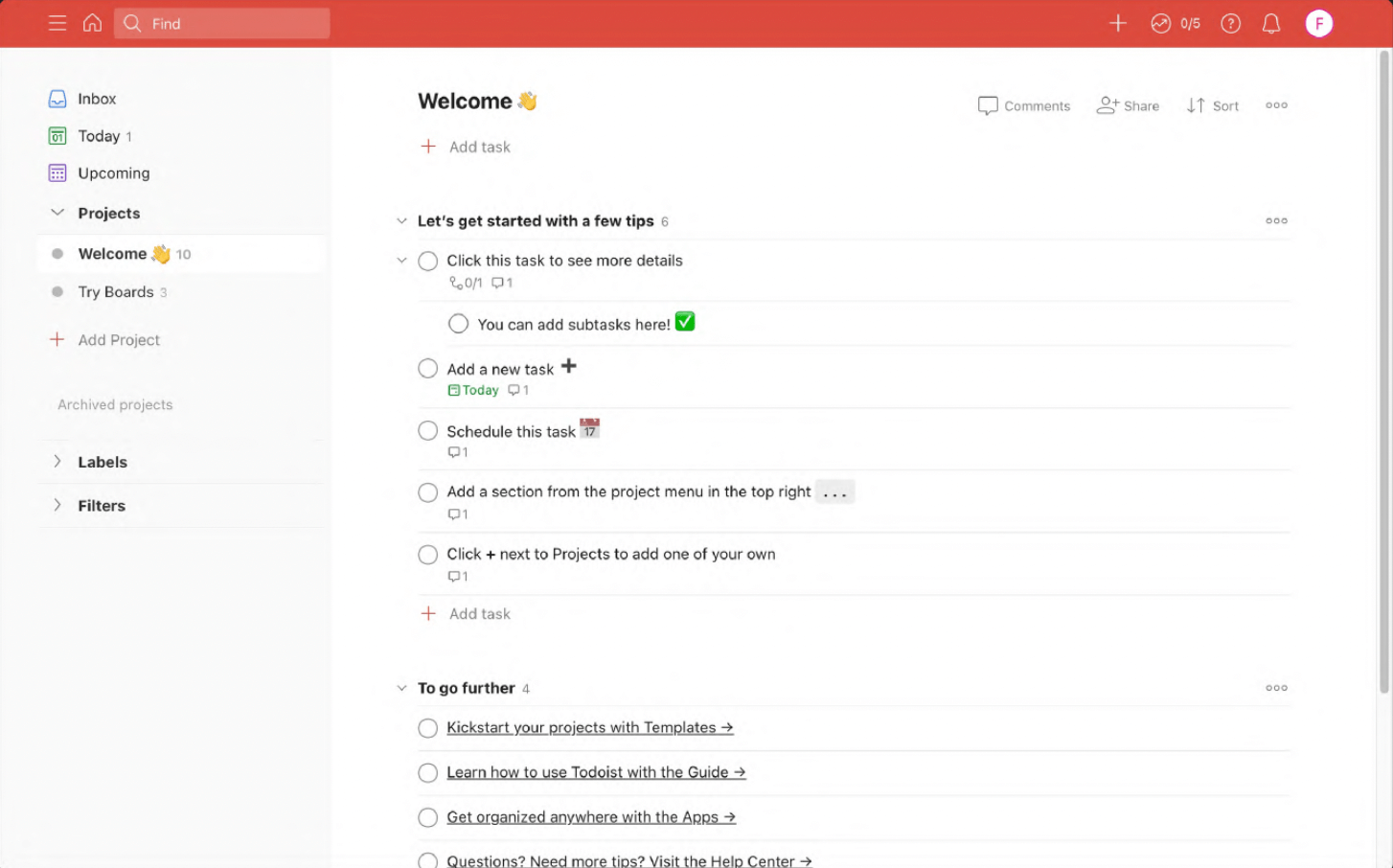
This is a great example of a starting screen that is not scarily blank, and one that allows the user to pick and choose what they want to learn and do.
First of all, the user can see what it would look like once the app is fully up and running. Secondly, they can choose whether they want to get hands on and start adding tasks and projects. Or, if they want to check some of the informational documentation there is available.
Zapier: get to know your users from hello
Zapier is a no-code process automation tool. It helps you automate workflows, whether you’re a large or small company, by letting you integrate the apps you already use and have.
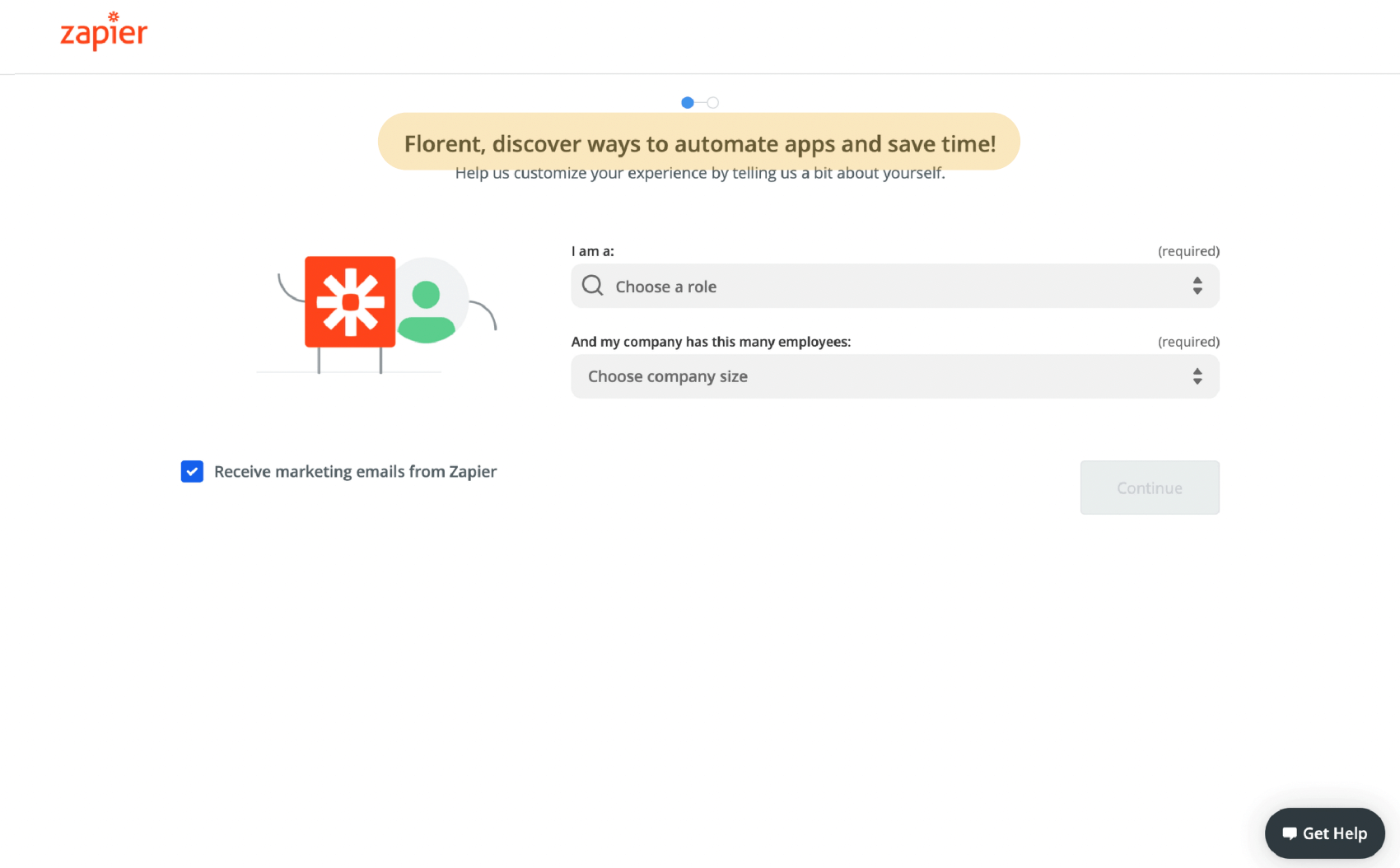
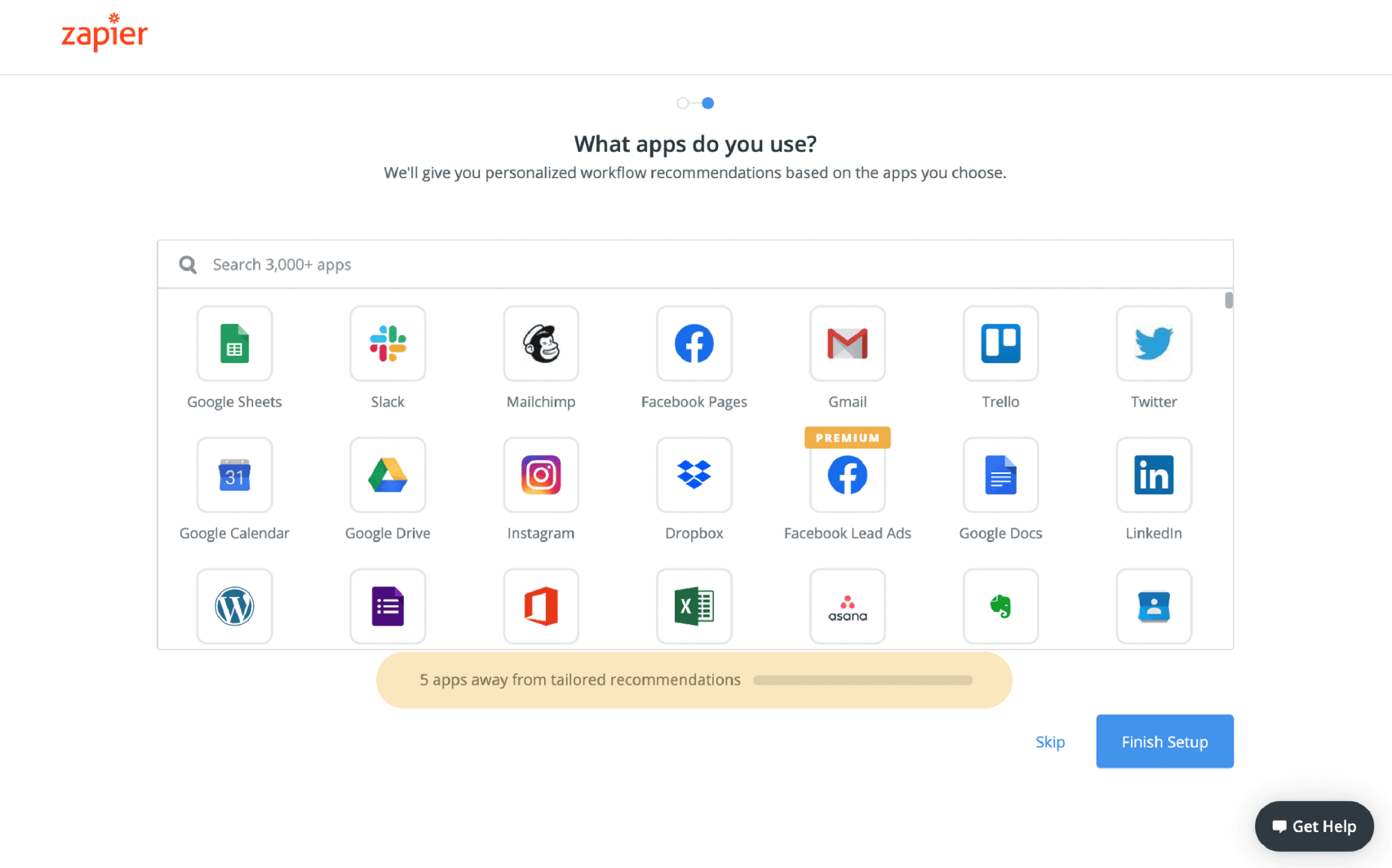
Zapier, in its third and fourth steps of the onboarding process asks the user important questions: it identifies who they are, what they do, and which apps they use. This helps Zapier give personalized recommendations throughout the onboarding process so the experience is relevant and targeted to this specific new user.
Additionally, Zapier manages user expectations. In the second window when they ask about the apps the user uses, they show a little message to let the user know why they are being asked this question. The answer is that the user is “5 apps away from tailored recommendations.” This way the user knows it’s not the only time they’ll be able to set apps up, and that’s it’s simply being asked to give a tailored experience, not to start the set up.
We must say there are some improvements to be made. On that first window, they are asking the user what their role and company size is, as well as asking them to opt-in marketing communications. Ideally, you want to avoid asking too many different things to a user on the same window – keep it to one window per task.
Maybe Zapier would have been better off asking about marketing communications on the initial sign up page. This way, each window is focused on one task alone.
Bonsai: find out the jobs-to-be-done
Bonsai offers templates for all sorts of business documents for freelancers. With it, you can create fully customizable contracts, project proposals, invoices, and any other paperwork you need and focus only on what you do best – your job.
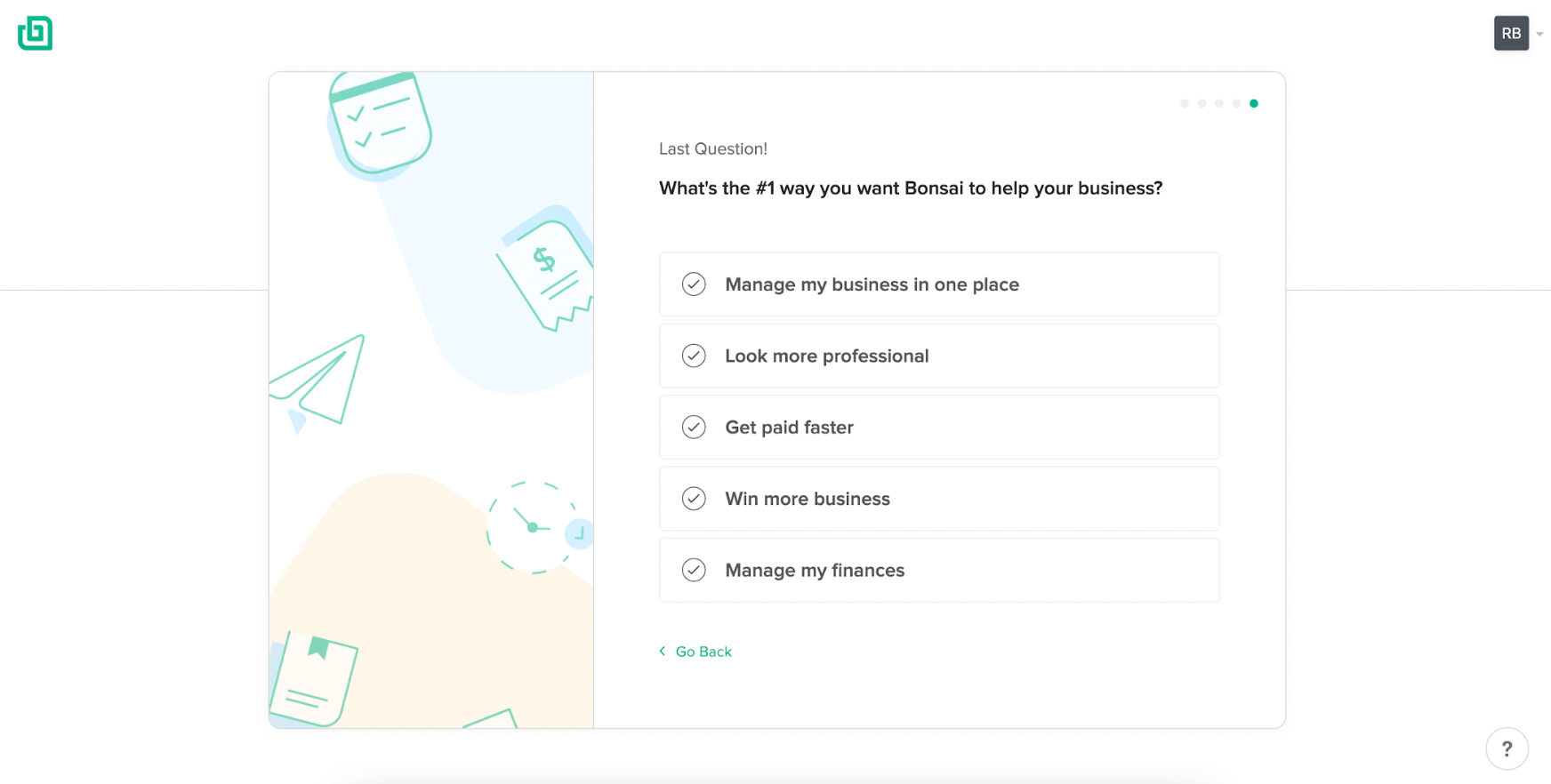
At the end of their initial onboarding phase, Bonsai asks its users for the way they want Bonsai to help their businesses. This is a great way to obtain insights into the jobs to be done that your new users are expecting to accomplish with your product.
As we’ve learned, this is fundamental to your onboarding experience but also to your marketing, sales, and customer success teams.
Waze: gamify your onboarding experience
Waze helps drivers know where there are roadblocks, traffic, and alternative routes to reach a destination. The idea of the app is that the more drivers it has, the more insights and more precise information it can give its users.
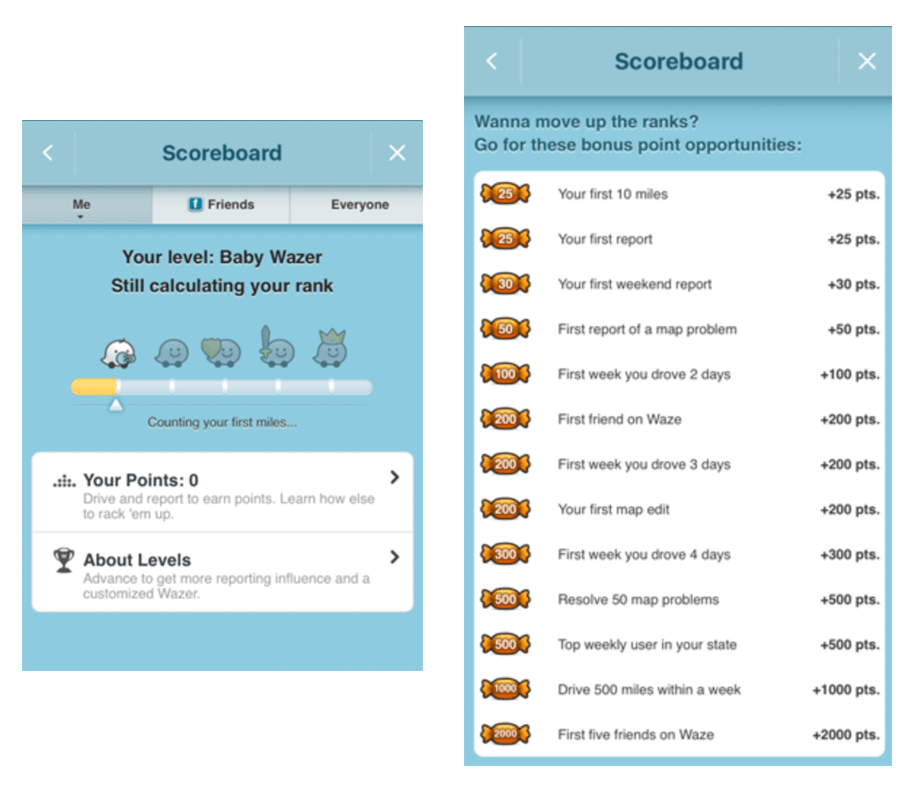
What Waze is showing us in these screenshots are great ways to allude to the competitive side of people and get them moving through the onboarding process and using the app much often. Remember that onboarding is not just about the aha! moment but about creating a habit in users. Only then will you be sure that you’re part of the user’s daily life.
Through these two gamification onboarding methods – having levels and rewards – you’ll increase your chances of your user using the app more often in order to obtain those things. Of course, not all industries and apps will be eligible for gamification, but there are other aspects of gamification like storytelling that you can definitely include in your experience.
Stop churn with a SaaS onboarding experience that makes your users see the value of your product
According to Florent Merian of Specify:
“User onboarding is the foretaste of your product.”
It’s important to understand how important it is and how fundamental it is for your product and your users.
With the checklist and concepts provided in this article, you’ll have everything you need to create the right environment and experience for your clients whether they are free users or paid customers
Before you’re off to using all of this information to create the ultimate SaaS onboarding experience take in these two pieces of advice:
From FirstPrinciple’s Padmaja Santhanam:
“User onboarding can help your business gain valuable insight into your customers’ needs, behaviors, and expectations. This information can be used to improve your product and marketing campaigns over time, leading to a more compelling customer experience.”
From Ramil John:
“Don’t think that activation or onboarding is when the person signs up or makes the first payment. It starts from way before that, and it ends way after that. Payment is not indicative of value. Just because they paid, it doesn’t mean they are using it, or that they will keep paying. They might churn out after the first payment – so make sure your onboarding is on point.”
That’s it. Now go and use all this expertise to get your users not to the aha! moment, but to the wow! moment with your brand and your product.
Happy onboarding!
Don’t miss out on new articles. Subscribe to our newsletter and get your monthly dose of SaaS email marketing insights.




